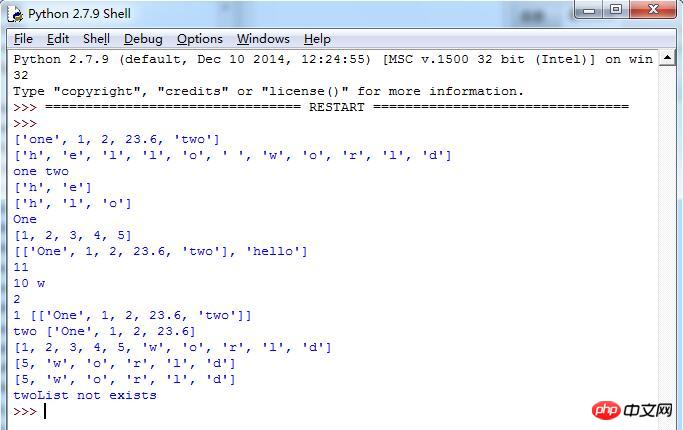本文实例讲述了Python列表操作。分享给大家供大家参考,具体如下:
#coding=utf8
'''''
列表类型也是序列式的数据类型,
可以通过下标或者切片操作来访问某一个或者某一块连续的元素。
列表不仅可以包含Python的标准类型,
而且可以用用户定义的对象作为自己的元素。
列表可以包含不同类型的对象,
列表可以执行pop、empt、sort、reverse等操作。
列表可以添加或者减少元素,
还可以与其他列表结合或者把一个列表拆分成几个。
可以对一个元素或者多个元素执行insert、update或者remove操作。
元组和列表主要不同之处在于,前者不可变(只读),
那些用于更新列表的操作,就不能用于元组类型。
列表是由方括号([])来定义的,也可以用工厂方法list()创建它。
可以通过在等号左边指定一个索引或者索引范围的方式来更新一个或几个元素,
也可以通过append()方法追加元素到列表中去。
要删除列表中的元素,如果确切知道要删除元素的索引可以用del语句,
否则可以用remove()方法。
还可以通过pop()方法来删除并从列表中返回一个特定对象。
一般来说,程序员不需要去删除一个列表对象引用。
列表对象出了作用域后它会自动被析构,但如果想删除一整个列表,可以使用del语句。
'''
#创建列表
oneList=["one",1,2,23.6,"two"]
#通过工厂函数创建list
twoList=list("hello world")
#创建一个初始化的表
threeList=[]
#输出列表中的内容
print oneList,"\n",twoList
#访问列表中的元素
#通过索引访问
print oneList[0],oneList[-1]
#通过切片访问,默认间隔为1
print twoList[0:2]
#通过切片访问,设置间隔为2
print twoList[0:5:2]
#更新列表中的元素
#通过索引更新元素
oneList[0]="One"
print oneList[0]
#通过切片更新几个元素
twoList[0:5]=[1,2,3,4,5]
print twoList[0:5]
#调用append()方法,向list中追加元素
threeList.append(oneList)
threeList.append("hello")
print threeList
#删除列表中的元素或列表本身
#del删除列表中某一元素
print len(twoList)
del twoList[5]
print len(twoList),twoList[5]
#remove删除列表中某一元素
print len(threeList)
threeList.remove("hello")
print len(threeList),threeList
#pop删除列表最后一个元素
#并把删除的元素保存为一个对象
print oneList.pop(),oneList
#使用切片删除一定范围内的元素
print twoList
del twoList[0:4]
print twoList
#删除一个列表引用
print twoList
try:
del twoList
print twoList
except Exception,e:
print "twoList not exists"运行结果:

更多Python相关内容感兴趣的读者可查看本站的内容,感谢大家对我的关注,我会继续努力的。
Atas ialah kandungan terperinci Python之列表操作实例教程. Untuk maklumat lanjut, sila ikut artikel berkaitan lain di laman web China PHP!
 Bagaimana tatasusunan digunakan dalam pengkomputeran saintifik dengan python?Apr 25, 2025 am 12:28 AM
Bagaimana tatasusunan digunakan dalam pengkomputeran saintifik dengan python?Apr 25, 2025 am 12:28 AMArraysinpython, terutamanya yang, arecrucialinscientificificputingputingfortheirefficiencyandversatility.1) mereka yang digunakan untuk
 Bagaimana anda mengendalikan versi python yang berbeza pada sistem yang sama?Apr 25, 2025 am 12:24 AM
Bagaimana anda mengendalikan versi python yang berbeza pada sistem yang sama?Apr 25, 2025 am 12:24 AMAnda boleh menguruskan versi python yang berbeza dengan menggunakan Pyenv, Venv dan Anaconda. 1) Gunakan pyenv untuk menguruskan pelbagai versi python: Pasang pyenv, tetapkan versi global dan tempatan. 2) Gunakan VENV untuk mewujudkan persekitaran maya untuk mengasingkan kebergantungan projek. 3) Gunakan Anaconda untuk menguruskan versi python dalam projek sains data anda. 4) Simpan sistem python untuk tugas peringkat sistem. Melalui alat dan strategi ini, anda dapat menguruskan versi Python yang berbeza untuk memastikan projek yang lancar.
 Apakah beberapa kelebihan menggunakan array numpy melalui array python standard?Apr 25, 2025 am 12:21 AM
Apakah beberapa kelebihan menggunakan array numpy melalui array python standard?Apr 25, 2025 am 12:21 AMNumpyarrayshaveseveraladvantagesoverstanderardpythonarrays: 1) thearemuchfasterduetoc-assedimplementation, 2) thearemorememory-efficient, antyedlargedataSets, and3) theyofferoptimized, vectorizedfuncionsformathhematicalicalicalicialisation
 Bagaimanakah sifat tatasusunan homogen mempengaruhi prestasi?Apr 25, 2025 am 12:13 AM
Bagaimanakah sifat tatasusunan homogen mempengaruhi prestasi?Apr 25, 2025 am 12:13 AMKesan homogenitas tatasusunan pada prestasi adalah dwi: 1) homogenitas membolehkan pengkompil untuk mengoptimumkan akses memori dan meningkatkan prestasi; 2) tetapi mengehadkan kepelbagaian jenis, yang boleh menyebabkan ketidakcekapan. Singkatnya, memilih struktur data yang betul adalah penting.
 Apakah beberapa amalan terbaik untuk menulis skrip python yang boleh dilaksanakan?Apr 25, 2025 am 12:11 AM
Apakah beberapa amalan terbaik untuk menulis skrip python yang boleh dilaksanakan?Apr 25, 2025 am 12:11 AMToCraftExecutablePythonscripts, ikutiTheseBestPractics: 1) addAshebangline (#!/Usr/bin/envpython3) tomakethescriptexecutable.2) setpermissionswithchmod xyour_script.py.3)
 Bagaimanakah array numpy berbeza dari tatasusunan yang dibuat menggunakan modul array?Apr 24, 2025 pm 03:53 PM
Bagaimanakah array numpy berbeza dari tatasusunan yang dibuat menggunakan modul array?Apr 24, 2025 pm 03:53 PMNumpyarraysarebetterfornumericationsoperationsandmulti-dimensialdata, whiletheArrayModuleissuitiableforbasic, ingatan-efisienArrays.1) numpyexcelsinperformanceandfunctionalityforlargedatasetsandcomplexoperations.2) thearrayModeMoremoremory-efficientModeMoremoremoremory-efficientModeMoremoremoremory-efficenceismemoremoremoremoremoremoremoremory-efficenceismemoremoremoremoremorem
 Bagaimanakah penggunaan array Numpy berbanding dengan menggunakan array modul array di Python?Apr 24, 2025 pm 03:49 PM
Bagaimanakah penggunaan array Numpy berbanding dengan menggunakan array modul array di Python?Apr 24, 2025 pm 03:49 PMNumpyarraysareBetterforheavynumericalcomputing, whilethearraymoduleismoresuitifFormemory-constrainedprojectswithsimpledatypes.1) numpyarraysofferversativilityandperformanceForlargedATAsetSandcomplexoperations.2)
 Bagaimanakah modul CTYPES berkaitan dengan tatasusunan di Python?Apr 24, 2025 pm 03:45 PM
Bagaimanakah modul CTYPES berkaitan dengan tatasusunan di Python?Apr 24, 2025 pm 03:45 PMctypesallowscreatingandmanipulatingc-stylearraysinpython.1) usectypestointerwithclibrariesforperformance.2) createec-stylearraysfornumericalcomputations.3) Passarraystocfuntionsforficientsoperations.however, becautiousofmemmemmemmemmemmemmemmemmemmemmemmemmemmemmemmemmemmemmemmemmemmemmemmemmemmemmemmemmemmemmemmemmemmemmemmemmemmemmemmemmemmemmemmemmemmemmemmemmemmemmemmemmemmemmemmemmemmemmemmemmemmemmemmemmemmemmemmemmemmemmemmemmemmemmemmemmemmemmemmemmemmemmem


Alat AI Hot

Undresser.AI Undress
Apl berkuasa AI untuk mencipta foto bogel yang realistik

AI Clothes Remover
Alat AI dalam talian untuk mengeluarkan pakaian daripada foto.

Undress AI Tool
Gambar buka pakaian secara percuma

Clothoff.io
Penyingkiran pakaian AI

Video Face Swap
Tukar muka dalam mana-mana video dengan mudah menggunakan alat tukar muka AI percuma kami!

Artikel Panas

Alat panas

Versi Mac WebStorm
Alat pembangunan JavaScript yang berguna

DVWA
Damn Vulnerable Web App (DVWA) ialah aplikasi web PHP/MySQL yang sangat terdedah. Matlamat utamanya adalah untuk menjadi bantuan bagi profesional keselamatan untuk menguji kemahiran dan alatan mereka dalam persekitaran undang-undang, untuk membantu pembangun web lebih memahami proses mengamankan aplikasi web, dan untuk membantu guru/pelajar mengajar/belajar dalam persekitaran bilik darjah Aplikasi web keselamatan. Matlamat DVWA adalah untuk mempraktikkan beberapa kelemahan web yang paling biasa melalui antara muka yang mudah dan mudah, dengan pelbagai tahap kesukaran. Sila ambil perhatian bahawa perisian ini

SublimeText3 versi Inggeris
Disyorkan: Versi Win, menyokong gesaan kod!

EditPlus versi Cina retak
Saiz kecil, penyerlahan sintaks, tidak menyokong fungsi gesaan kod

Notepad++7.3.1
Editor kod yang mudah digunakan dan percuma






